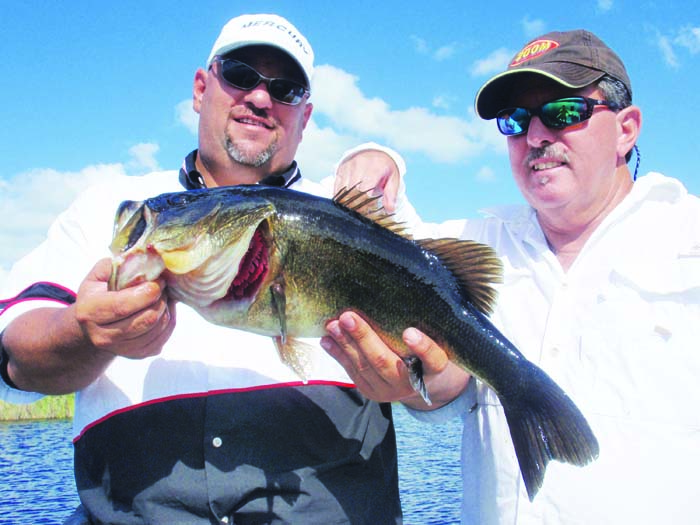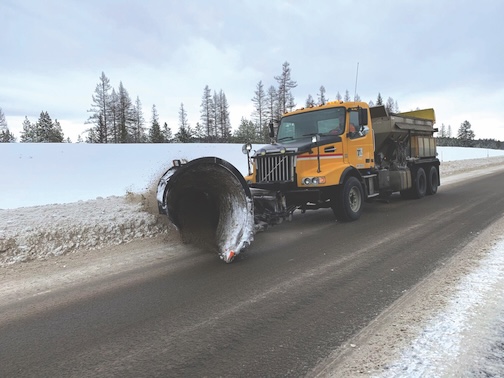Caught Ovgard: Swimbaits: They’re not just for bass
Published 3:00 am Saturday, March 23, 2024

- Ross Myers looks at a bass caught by Roy Singer, left, on a canal at the Loxahatchee National Wildlife Refuge in southern Palm Beach County, Florida. Singer used a Gambler Big E-Z swimbait.
As it turns out, the high-strung lady trying to quit smoking in the office next to you doesn’t have the highest blood pressure of any living thing. No, that unfortunate title goes to the small fishes swimming in your local lakes, ponds, rivers and streams.
Trending
Not a single drug could touch the mounting stress that minnows tremble through every day. Everywhere these poor, victimized critters swim, something is looking to eat them. Virtually nothing considers Leuciscids (the New World minnow family) and other bait fishes off limits, so every time a shadow crosses the water, schools of silver and gold dart for cover, collectively fearing the teeth and claws of birds, mammals and larger fish that could end their short, highly stressful lives constantly shaped by terror.
What could make a better horror film than a tiny fisheye camera mounted to the shiner, chub or minnow that will live in abject horror until its violent end?
Nature is a cruel, terrifying place, but as anglers, capitalizing on the brutality of the food chain is a must. Angling, at its core, is trying to convince large fish to eat whatever is on the end of line, and few lures do a better job of targeting apex predators Hell-bent on swallowing anything they can fit in their mouths than swimbaits.
Trending
History
Before a lure ever hooks a fish, it must first hook the angler throwing it.
The annals of the internet will tell the history of the swimbait. Numerous accounts exist, but perhaps the most detailed is a 2006 story by Mark Rogers on the FLW website. The story tells of a Southern California man named Allan Cole who successfully used a hand-carved lure the size and color of a hatchery rainbow trout for striped bass planted there by the California Department of Fish and Game in the early 1990s. It was hugely successful, and within a decade, the swimbait industry had fully commercialized.
By the time that 2006 story was written, swimbaits were mainstream in the bass community, and for good reason: bass aggressively devour swimbaits.
Today, no self-respecting tournament angler would be caught dead without at least one swimbait rod loaded and ready to go — especially in late March and early April as bass begin to stage for spawning in Oregon’s higher elevations.
Swimbaits for bass
Swimbaits come in all shapes and sizes, but for bass, the 8-inch size is typically most popular, as it mimics the hatchery rainbow trout stocked in almost every Cascade, Siskiyou or Rocky Mountain state that provide an all-you-can-eat buffet for the bass sharing the same waters.
Since a 2-pound largemouth can easily swallow an 8-inch trout, and smallmouth and spotted bass not much larger than that will also devour an 8-inch slab of meat swimming across their path, swimbaits are a no-brainer.
Colby Pearson, a tournament bass angler who once managed the Klamath Falls Sportsman’s Warehouse and sees no shortage of swimbaits in all shapes and sizes, says swimbaits are “absolutely my go-to” when chasing bass.
“Swimbaits,” he continued, “when presented correctly, offer a conducive feeding opportunity for bass to capitalize upon a large meal while expending very little energy.”
As with all bass angling, there are a lot of considerations.
Key considerations for swimbaits include the type of water you’re fishing (lake, pond, river), the species you’re targeting, and the water temperature.
The water
You need not travel to the nation’s largest artificial lakes in the Rocky Mountains, waters like Arizona’s Lake Havasu, to find great opportunities for fishing swimbaits.
Big water can be difficult to fish, anyway. Instead, anglers should focus on finding baitfish and structure that baitfish hides in if they want to find the bass. Literal piles of structure exist in your local lakes and ponds, many of them artificially installed (i.e., dead Christmas trees or cinder blocks) to improve bass fishing.
Slow swimming a large swimbait that mimics a native bait fish such as the numerous chubs, suckers or pikeminnow can be effective for the largemouth, smallmouth and hybrid bass that call Oregon home. These bait fish are typically silver, gold or copper, so start with a lure 3 to 5 inches long that mimics this natural forage.
Big water does, in fact, hold big fish, but smaller waters can fish very well, too. Just try to throw a swimbait that matches local forage. You won’t have stocked rainbows swimming around a golf course pond or a wild and scenic river bass have found their way into, but you might have chubs or fathead minnows, so plan accordingly and bring swimbaits that match the local forage.
The species
Bass react differently to swimbaits. Largemouth usually hit head-first.
Smallies will hit head-first, but often hit from the side as they streak out from rocks or other cover to lay waste to a hapless baitfish.
Spots can hit almost anything any which way any time of the year, and are usually the easiest to catch of the black bass species.
Unlike most other bass you’ll chase, hybrid bass will often chase and hit baits from behind.
Knowing what species you have present in the water you’re fishing will help you determine when to set the hook.
A head-on hit from a largemouth should warrant a fast, hard hookset.
A sideswipe from a smallie or spot will often be followed by a second, better hit, so use your judgment here. Setting the hook on a sideswipe will usually result in disappointment unless the bass is massive or the bait is small.
With a tail-biting strike from a striper, you’ll feel a tap-tap-pull that is the fish biting down as it pursues what it believes to be fleeing prey, chomping down as it overtakes and swallows the terrified fish. Set the hook once you feel a solid weight and hold on for dear life.
The temperature
In addition to the species, temperature is highly important when fishing swimbaits. Water that is extremely hot or cold will usually result in a slow bite. Anglers usually go deep to target bass insulated from the extremes of temperature, and swimbaits make for an excellent choice in these circumstances.
In highly-oxygenated warmer water, like the riverine environments of the lower Gila River in New Mexico that smallmouth bass thrive in, bass will still feed readily because the flowing water keeps dissolved oxygen levels high and fish metabolism healthy. But in ponds or lakes where high temps reduce oxygen levels, expect bass to be lethargic.
Work your swimbait slowly, twitching or twisting as needed to elicit that strike.
Cold water fishes similarly. Fish metabolism slows in colder water, so you’ll have to work that much harder to convince them to eat.
In ideal temperature ranges for your target bass species, swimbait fishing will be fairly straightforward. Find a large swimbait you like and use it. Huddleston makes the most popular swimbaits, but they can easily top $100. A great value pick is the Savage Gear 3D Real Trout, which retails for under $10.
Fish are hungry, so feed them. Feed them big meals, and don’t be surprised when your line goes taut.
Swimbaits for trout, too
But swimbaits aren’t just for bass. Open up a browser and type “swimbaits for” and see the laundry list of species Google attempts to complete your thought with. It’s not short.
Swimbaits can be used for any piscivorous species, that is, a fish that eats other fish.
On the Oregon Coast, you might see people using them in saltwater for rockfish or lingcod. Perhaps on the Columbia for walleye or in the John Day for big catfish. Regardless, they work.
Personally, I prefer them for big trout.
Now, some folks might get upset that I’m writing this, but given that I started using swimbaits for trout before I even finished puberty I reserve the right of early adopter to bestow the knowledge as I please.
In 2001, at age 11, I caught my first “big” trout while fishing the Link River with my dad. I snagged my Rapala on a clump of moss a few casts later. When I waded out to free it, I noticed a small (2-inch) swimbait snagged to the same vegetation. It wasn’t heavy enough for fast current, so I convinced Dad to buy some slightly bigger ones, and it has been my favorite trout lure for nearly 25 years. I know I wasn’t first, so thank you to whomever snagged that little rubber fish back in the day; you changed the game.
Most importantly, swimbaits are better for fragile trout since they bear a single hook that faces upward and not down into the fish’s sensitive gills. I’ve killed exactly one trout on a swimbait in my life, and it was only because a bad cast looped the line around the swimbait and flipped it upside down. The fact that even upside down it still caught fish is an indictment of its efficacy.
Given their sharp teeth, trout will ravage swimbaits a lot faster than bass, so don’t use the $100 Huddleston swimbait on these guys. Instead, opt for cheaper swimbaits like the Storm Wild Eye Swim Shad which comes in a pack of three for less than $7.
Tails
Regardless of the species, swimbaits are downright effective. If that ball of bait erupting from solace into chaos at the touch of a shadow is any indication, capitalizing on the terror of baitfish is the best way to a trophy fish.
All fishing is a coin toss, but I choose tails. Big, rubbery ones.









